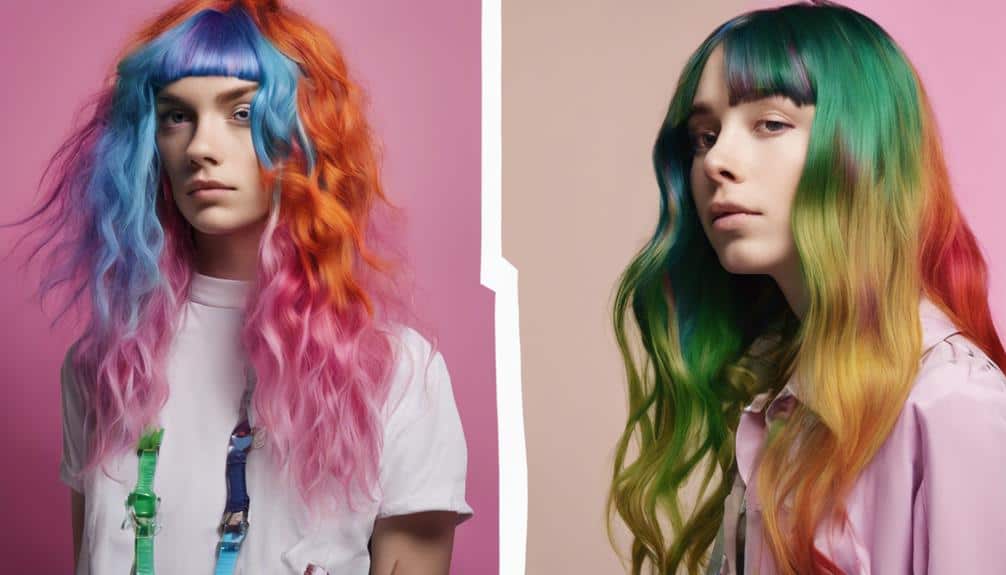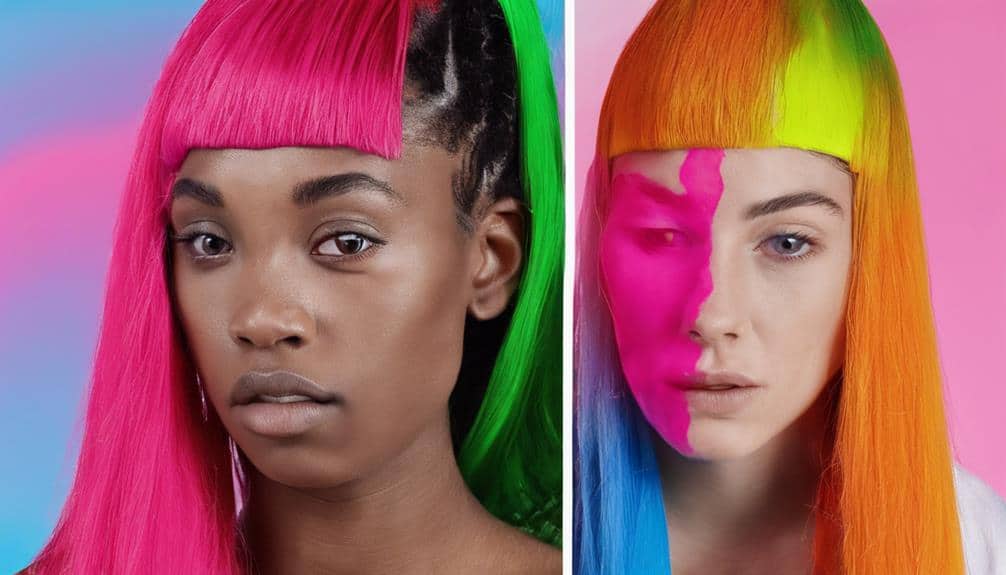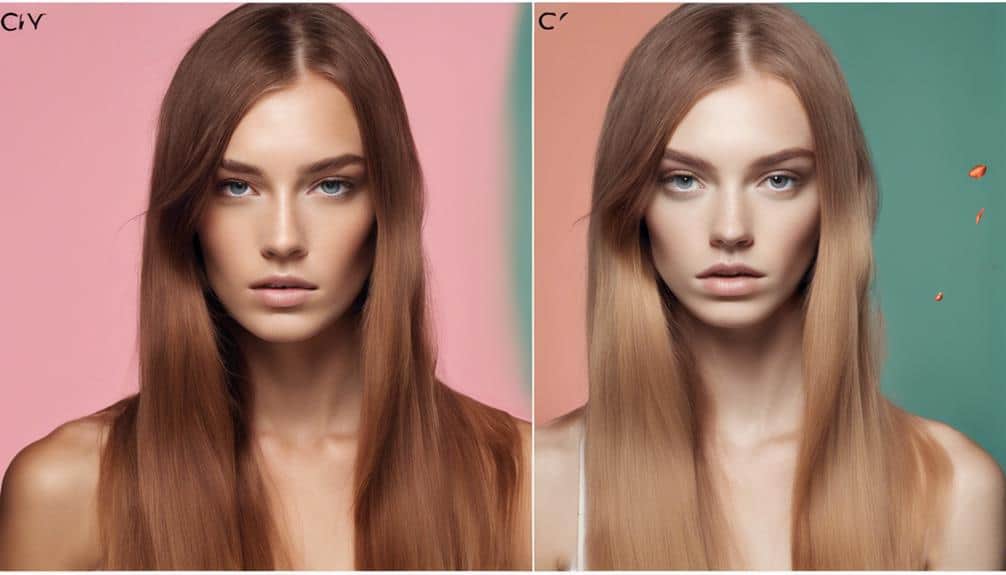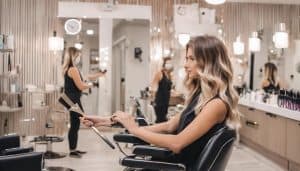Ensuring the safety and effectiveness of the process is crucial as you prepare to strip the color from your hair. Start by washing your hair with a clarifying shampoo to remove product buildup. Next, choose a method that suits your hair type, such as using vitamin C tablets, olive oil treatment, or a cinnamon and honey mask. Be cautious when using chemical-based strippers, and consider gentler alternatives. Before you begin, make sure to deep condition your hair and remove heavy product buildup. By following the right steps, you'll be on your way to successfully stripping your hair color, and there's more to learn about maintaining healthy, vibrant locks.
Key Takeaways
• Use a clarifying shampoo to remove product buildup and dye residue before stripping hair color.
• Vitamin C, olive oil, cinnamon, and honey are natural ingredients that can gently strip semi-permanent and demi-permanent hair dyes.
• Chemical-based hair strippers pose risks of hair damage, so consider gentler alternatives like ammonia-free formulas.
• Pre-strip hair care tips include washing with clarifying shampoo, avoiding heavy conditioners, and deep conditioning beforehand.
• Post-strip hair care involves using hydrating conditioners, deep conditioning treatments, and establishing a consistent hair care routine to replenish lost moisture.
Understanding Hair Color Removal
When you decide to remove artificial hair color, it's important to understand that the process involves stripping the pigment from your hair strands, rather than just washing it out. This is a vital distinction, as many people mistakenly believe that removing hair color is as simple as using a clarifying shampoo. However, stripping hair color requires a more targeted approach.
The goal of hair color removal is to break down and lift the dye molecules from your hair strands. This process can be damaging if not done correctly, which is why it's crucial to understand the different methods available. You'll need to take into account your hair type, previous treatments, and desired results to choose the most effective approach.
Bleaching, for instance, is often confused with stripping, but they're not the same. Bleaching involves using chemicals to break down the melanin in your hair, whereas stripping involves removing the artificial pigment without damaging the underlying hair structure. It's important to understand the difference to avoid damaging your hair.
Safe and Effective Methods

To strip hair color safely and effectively, you can try several methods that are gentle on your hair while successfully removing unwanted dye molecules. These methods not only guarantee color removal but also protect your hair's health and integrity.
Here are some safe and effective methods to strip hair color:
| Method | Description | Benefits |
|---|---|---|
| Clarifying Shampoo | Use a clarifying shampoo to remove product buildup and dye residue. | Gentle, easy, and effective for removing semi-permanent dyes. |
| Vitamin C Tablets | Crush Vitamin C tablets, mix with water, and apply to damp hair for 30 minutes. | Effective for removing semi-permanent and demi-permanent dyes. |
| Olive Oil Treatment | Warm olive oil, apply to hair, cover with a shower cap, and shampoo. | Gently loosens dye molecules from hair strands. |
| Cinnamon and Honey Mask | Mix honey, cinnamon, and conditioner, apply to damp hair overnight. | Gradually lightens hair dye while leaving a pleasant scent. |
Additionally, exercising and sweating can help break down dye with the natural salts in sweat, and outdoor exercise can benefit from the sun's bleaching effect. Just remember to wash your hair post-workout to prevent buildup and damage.
Natural Ingredients for Stripping

You can harness the power of natural ingredients to strip your hair color, leveraging their unique properties to break down and remove unwanted dye molecules. One effective method is to create a Vitamin C paste, which can strip semi-permanent and demi-permanent hair dyes by breaking down the color molecules. Simply apply the paste to your hair, leave it on for about an hour, and then rinse thoroughly.
For a gentler approach, try an olive oil treatment to fade permanent hair dye. The oil helps loosen dye molecules from the hair strands, resulting in a subtle, gradual lightening effect. Apply the olive oil to your hair, cover with a shower cap, and leave it on for a few hours or overnight before shampooing.
Another natural ingredient combination is the cinnamon and honey mask. This sweet and spicy duo can gradually lighten hair dye while leaving a pleasant scent. The natural ingredients' dye-lifting properties make it an ideal treatment for those looking to strip unwanted hair color.
Additionally, you can use lemon juice in a rinse to contribute to gradual lightening of hair dye. This milder approach to color stripping is perfect for those with sensitive scalps or natural hair.
And, believe it or not, exercise and sweat can also aid in breaking down hair dye. The natural salts in sweat help to gradually fade the color, especially when combined with outdoor sun exposure.
Chemical-Based Hair Strippers

Now that you've considered natural ingredients, it's time to explore chemical-based hair strippers, which come with their own set of considerations.
You'll want to be aware of the potential risks of hair damage, as well as the differences between bleach-based formulas and ammonia-free options.
As you navigate these strong products, it's essential to understand the pros and cons to achieve the desired results while protecting your hair.
Hair Damage Risk
When using chemical-based hair strippers, beware that you're exposing your locks to harsh ingredients that can wreak havoc on your hair, leading to dryness, breakage, and loss of natural oils. These products can be risky, and it's important to understand the potential damage they can cause.
Here are some potential risks to keep in mind:
- Scalp irritation and allergic reactions: Harsh chemicals can cause itchiness, redness, and discomfort on your scalp.
- Over-processing and weakening: Improper use can lead to over-processing, weakening your hair structure, and making it more prone to further damage.
- Long-term damage: Chemical-based strippers can cause permanent damage to your hair, leading to dryness, brittleness, and breakage.
- Loss of natural oils: Stripping your hair of its natural oils can lead to dryness, frizz, and unmanageability.
To minimize the risks, it's important to follow instructions carefully, do patch tests, and consider seeking professional advice when using chemical-based hair strippers. Remember, stripping your hair color is a process that requires caution and attention to detail to avoid damaging your locks.
Bleach-Based Formulas
Bleach-based formulas, the most potent of chemical-based hair strippers, are designed to tackle even the darkest, most stubborn hair colors by breaking down the hair's natural pigment and removing artificial dye molecules. As you consider using bleach-based formulas to remove hair dye, it's important to understand the risks involved. These formulas can cause dryness, breakage, and scalp irritation if not used correctly or left on for too long.
Here's a breakdown of what you need to know:
| Formula Type | Effectiveness | Risk Level |
|---|---|---|
| High-Lift Bleach | Excellent for removing dark colors | High |
| Medium-Lift Bleach | Suitable for removing semi-permanent dyes | Medium |
| Low-Lift Bleach | Gentle for removing temporary dyes | Low |
| Extra-Strength Bleach | Aggressive for removing stubborn colors | Very High |
When using bleach-based formulas, it's important to follow instructions carefully and consider professional help for safe and efficient color removal. Remember, bleaching your hair can be a high-risk, high-reward process. With the right approach, you can effectively fade permanent hair color and start anew.
Ammonia-Free Options
You'll find that ammonia-free hair strippers offer a gentler alternative to traditional bleach-based formulas, making them an attractive option for those seeking to remove hair color without excessive damage or dryness. These products are designed to break down the color molecules in your hair, allowing you to wash out the unwanted color without stripping your hair of its natural oils.
Here are some key benefits of ammonia-free hair strippers:
- Gentle on hair: Ammonia-free options are less harsh than traditional bleach-based formulas, making them suitable for sensitive scalps and hair.
- Effective color removal: These products can effectively strip hair color without causing excessive damage or dryness.
- Suitable for sensitive scalps: If you have allergies to ammonia or sensitive skin, ammonia-free hair strippers are a great alternative.
- May require multiple applications: While effective, it may take a few applications to completely strip the color from your hair.
Preparing Your Hair for Stripping

Before stripping your hair color, take the time to prepare your locks by washing them with a clarifying shampoo to remove any product buildup that might interfere with the stripping process. This step is important to make sure the color stripping process is effective and efficient.
| Pre-Stripping Tips | Why It Matters |
|---|---|
| Wash with clarifying shampoo | Removes product buildup, ensuring effective stripping |
| Avoid heavy conditioners | Prevents interference with the stripping process |
| Deep condition beforehand | Minimizes potential damage |
Post-Stripping Hair Care Tips

Now that you've stripped your hair color, it's crucial to focus on moisturizing and nourishing your locks to prevent dryness and breakage.
You'll want to use a hydrating conditioner and consider a deep conditioning treatment or hair mask to restore strength and vitality to your hair.
Moisturizing and Nourishing
Following the stripping process, your hair's natural moisture barrier is disrupted, making it important to replenish lost moisture and prevent dryness and damage with a hydrating conditioner. This essential step in your post-color removal hair care routine helps restore your hair's natural moisture balance, keeping it hydrated, manageable, and healthy.
To achieve ideal hair health, remember these key moisturizing tips:
- Use a hydrating conditioner specifically designed for post-color stripping care to nourish your strands.
- Replenish lost moisture with a moisturizing treatment once a week to keep your hair hydrated.
- Establish a consistent hair care routine that includes regular conditioning to maintain hair health.
- Choose products that are formulated to address the unique needs of post-color stripped hair, ensuring your hair receives the attention it needs to thrive.
Protecting From Damage
To prevent further damage and breakage, you'll need to take proactive measures to safeguard your stripped hair from environmental stressors and styling tools. After stripping color from your hair, prioritizing protection is crucial to maintain its health and appearance.
Start by treating your hair to a deep conditioning treatment to restore moisture and strengthen your strands. Next, avoid using heat styling tools and minimize washing to prevent excessive stress on your hair. When you do wash, opt for sulfate-free shampoos and gentle hair products to maintain hair health.
Consider trimming split ends to prevent further damage and breakage. To protect your hair from UV rays and environmental stressors, wear hats or use protective styling. By taking these measures, you can enjoy your newly stripped hair without worrying about damaging your hair further.
Common Mistakes to Avoid

When stripping your hair color, it's important to sidestep common pitfalls that can lead to damaged, brittle locks. You want to achieve the best results, not compromise the health of your hair.
To avoid damaging your hair, it's vital to steer clear of common mistakes that can lead to unwanted color, dryness, and breakage.
Here are some common mistakes to avoid when stripping hair color:
- Using harsh chemicals without proper knowledge or experience: Don't risk damaging your hair with bleach or other strong chemicals without knowing how to use them safely.
- Rushing the color stripping process: Take your time, and don't over-process your hair to avoid dryness and breakage.
- Skipping the patch test: Always do a patch test before trying a new hair color stripping method to make sure you're not allergic to any ingredients.
- Excessive heat styling or chemical treatments after color stripping: Give your hair a break and avoid further stress after stripping your hair color.
What is the Best Method for Stripping Color From Hair?
The best removing hair color technique varies depending on hair type and the desired end result. Some popular methods include color-removing shampoos, bleach baths, and color faders. It’s important to consider the health of your hair and consult with a professional before attempting to strip color from your hair.
Frequently Asked Questions
How Can I Strip My Hair Color at Home Fast?
Want to strip your hair color at home fast? You've got options! For a quick fix, try a clarifying shampoo to gradually remove color buildup.
Alternatively, whip up a Vitamin C paste and leave it on for 30 minutes to fade semi-permanent dyes. Or, mix baking soda and water to create a paste that lifts pigment from hair strands.
These methods won't damage your locks, and you can do them in the comfort of your own home!
How Can I Get Color Out of My Hair Without Damaging It?
You want to remove color from your hair without causing damage. Start by using gentle methods like clarifying shampoo or vitamin C paste to strip the color.
Avoid harsh chemicals that can dry out your hair. Be cautious, especially if you've previously bleached or have fine hair.
After removing the color, prioritize moisturizing and conditioning to replenish lost moisture and maintain hair health.
How Damaging Is Stripping Hair Color?
As you stand at the edge of the color-stripping precipice, you wonder how damaging it'll be.
The truth is, stripping hair color can be a treacherous journey, leaving your locks parched, brittle, and prone to breakage. Harsh chemicals can ravage your hair's natural oils, causing damage that's hard to repair.
But don't let fear hold you back – with gentle, safe methods, you can navigate this process with minimal harm.
How Do Hair Stylists Remove Color?
As you sit in the stylist's chair, wondering how they'll remove that unwanted color, here's what happens:
Your stylist will assess your hair type, color, and condition to tailor the removal process. They might use professional color removers with sulfates or ammonia, or opt for color correction techniques like blending, highlighting, or lowlighting.
Whatever the approach, they'll work to minimize damage and restore moisture with a deep conditioning treatment afterwards.
Conclusion
Now that you've stripped your hair of its color, you're probably wondering: will it ever be the same? The answer is, it can be, with the right care. Remember, stripping your hair of its color is just the first step – the real work begins after.
So, be patient, stay committed, and don't skip those post-stripping hair care tips. Will you be able to restore your hair's natural health and shine? Only time (and proper care) will tell.


